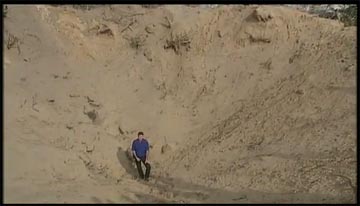
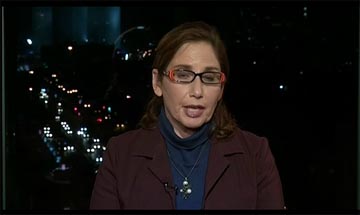
The Israel segment, with freelance reporter Stephanie Freid, included not one single shot of destruction in southern Israel, though the damage from 1,500 rockets is extensive. Freid reported from Tel Aviv. All that is visible behind her is a night view of the lights from buildings and traffic. See the Israel segment here.
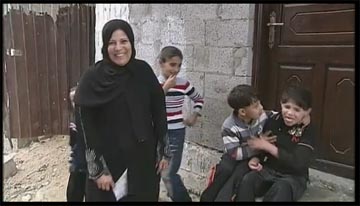
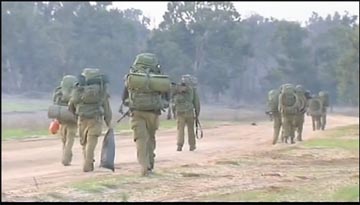
On the Israeli side, there are no interviews with ordinary citizens. No mothers. No injured. There is no footage of children cowering in shelters, or children smiling once the constant threat of rockets lifts somewhat. There is not a single image of a single Israeli child, disabled or otherwise. There is no footage of Israelis affected by the onslaught of 1,500 Palestinian rockets. There is not one picture of Israeli civilians affected by the unprecedented rocket bombardment. The Israelis in the Israel segment are soldiers, along with their tanks and weaponry. Although the beginning opens with scenes from the Tel Aviv bus bombing, there is not a single image relating to the property or human toll suffered in the rocket attacks. (And viewers do not meet any victims from the bus bombing.)
In the Gaza segment, viewers see and hear the victims firsthand, and they learn their names and stories. In the Israeli segment, there are no personal stories, and not even any faces. Nothing firsthand. Instead, reporter Freid, with the twinkling Tel Aviv traffic behind her, talks, not very articulately, about the unnamed Israeli victims: “I was in one specific town today. It wasn’t the ghost town that they had been all week. People are not as shaken…. They were grateful, relieved, glad to be out getting their hair cut, doing their shopping, going about business, stocking up on some goods…..”
In Gaza, the smiling mother Sabbah of Al‑Atatra interprets the expression of her disabled son, Awad, as “mean[ing] he’s feeling happy and safe.” The humanizing footage of Sabbah and her children makes her plight very real, and naturally encourages viewer identification. In contrast, “Newshour” doesn’t even tell viewers the name of the southern Israeli town that Freid visited, much less provide names and footage of the Israeli mothers and children of the south.
The imbalances don’t end there. In addition to humanizing ordinary Palestinians, but not Israelis, “Newshour” lets Palestinian political figures and analysts give their firsthand take on the situation. Thus, we hear from Ahmed Yousef, a senior Hamas adviser: “If the Palestinians will stay under occupation in the West Bank and here under Israeli, Gaza under siege, I don’t think there is going to be a long cease‑fire. In one day or in a few days, a few weeks, a few months, they’re going to break this cease‑fire, yes.”
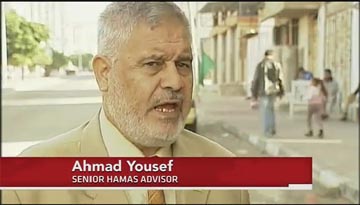
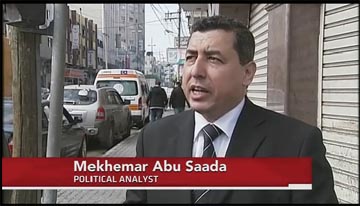
In the Israel segment, by contrast, not a single Israeli politician or political analyst is permitted to address viewers. Not one speaks in his own voice, with his own name and face. Instead, just as she tells viewers about her observations of Israeli citizens, reporter Freid also talks about her discussion with an unnamed political analyst: “I did speak to a political analyst this evening, and he said there won’t be long‑term negotiations. That was his – his basic take on this entire situation is that four years after Cast Lead, there was an agreement put into place. He said there were dozens of clauses. He said not one was adhered to. He said there won’t be any long‑term negotiations in terms of real time or anything significant in moving forward.”
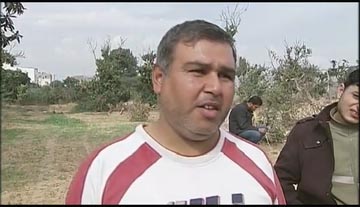 Why do Palestinian figures and analysts get to address viewers in their own words while Israelis don’t? Perhaps the Israeli analyst was making the point that it was the Palestinians who violated all of the post‑Cast Lead clauses. We don’t know, because all we have is Freid’s vague paraphrasing: “He said there were dozens of clauses. He said not one was adhered to.” Notice the passive voice. Freid does not indicate whether the analyst said which party was responsible for violating the clauses. In contrast, Hamas’ Yousef states clearly, accusing the Israelis: “In one day or in a few days, a few weeks, a few months, they’re going to break the cease‑fire, yes.” Another unnamed interviewee in Gaza (at left) echoes the char
Why do Palestinian figures and analysts get to address viewers in their own words while Israelis don’t? Perhaps the Israeli analyst was making the point that it was the Palestinians who violated all of the post‑Cast Lead clauses. We don’t know, because all we have is Freid’s vague paraphrasing: “He said there were dozens of clauses. He said not one was adhered to.” Notice the passive voice. Freid does not indicate whether the analyst said which party was responsible for violating the clauses. In contrast, Hamas’ Yousef states clearly, accusing the Israelis: “In one day or in a few days, a few weeks, a few months, they’re going to break the cease‑fire, yes.” Another unnamed interviewee in Gaza (at left) echoes the char
ge against Israel: “They have been breaking their promises since the prophet’s day.”
Nor can we even fact‑check the quote with the Israeli analyst, since Freid does not identify him.
But the stacked deck is even worse. Not only does Thomson include footage of Abu Saada and Hamas’ Yousef, but he even elaborates on Yousef’s argument, adding his own falsehood and distortions to Yousef’s charges against Israel. Thomson follows up after Yousef: “By occupation, he means this [shows view of a crossing], Erez, just one militarized crossing from Gaza to Israel. And Israel decides what crosses, goods, people. It is a complete commercial stranglehold on a place desperate to be a country.”
In fact, two crossings – Erez and Kerem Shalom – service the Gaza Strip from Israel. Even during Pillar of Defense, when Palestinians were bombarding Israel with rockets, and even targeting the crossings, Erez crossing operated nearly continuously “except for times that its workers have been endangered by rocket and mortar fire from Gaza,” according to the Coordinator of Government Activities in the Territories (or COGAT). In addition, Kerem Shalom was also in operation at various points throughout “Pillar of Defense.” For instance, on Nov. 20, Kerem Shalom opened to allow the transfer of 120 trucks filled with humanitarian goods. Only 24 truckloads went through, however, when the crossing “was targeted by rocket fire from Gaza, the IDF was forced to close the crossing to ensure the safety of all those working at the crossing and passing through.”
While Israel opens crossings, endangering its workers, so as to transfer humanitarian goods to the population under Hamas rule, Hamas launches rockets at those crossings. Is this normal activity for “a place desperate to be a country,” as Thomson puts it?
The conflict between Israel and the Palestinians is nothing if not controversial — yet the Nov. 22 “Newshour” segment was partisan, factually flawed and unbalanced.
I also thought this was a poorly done segment, at least in part, that was certain to generate legitimate criticism. I had that feeling immediately as I watched it on the 22nd. I did not feel it betrayed intentional bias, however, because I also watch the NewsHour almost every night and I had seen earlier segments on the fighting, including reports from Israel of the threat from and damage by rockets launched from Gaza, and a lengthy interview with the Israeli ambassador in Washington, Michael Oren, among other clips presenting the Israeli view. I’ve made the point many times that news programs need to be judged on a continuum of coverage rather than on any one segment which self-interest groups can use as a hammer to try and make a larger point.
The segment was anchored by NewsHour correspondent Hari Sreenivasan and featured two parts. The first was a filmed report on the scene in Gaza by Alex Thomson of Britain’s Independent Television News. The second, which was the problem, in my opinion, was a static, long-distance interview by Sreenivasan with a freelance journalist, Stephanie Freid, who was in Tel Aviv on what seemed to be a rooftop, with normal, busy nighttime traffic and lights from buildings in the distance. The content and contrasts between the two reports were stark. It was the first time Freid had appeared on the NewsHour.
Perhaps viewers need to be reminded that Israel pulled its troops and settlers out of Gaza in 2005. That Gaza City, though cut-off from the West Bank, is the largest Palestinian city, with some 450
,000 people. That militant organizations other than Hamas fire rockets from Gaza into Israel. That those rockets are seen by many Palestinians as resistance to Israeli occupation of the West Bank. Do most Gaza residents really agree with those rocket attacks since they are certain to bring Israeli counter-attacks that often leave them and their homeland ever more devastated? What is the actual role of other Arab nations in helping, if that’s what they do, Gaza residents cope? What is the current extent and real impact of the Israeli blockade? There are many more questions.
In its November 22 report on reactions to the ceasefire between Israel and Hamas, we sought to provide perspective from both sides, based on the material available to us. We do take CAMERA’s point, that on the particular broadcast in question (November 22), the report from Gaza contained video footage shot on location, while the report from Tel Aviv was primarily an interview with a reporter on the scene. (That report opened with images of people injured in a Tel Aviv bus bombing and also discussed how civilians in southern Israel have faced rocket attacks for years.) The NewsHour produced coverage of the conflict every day last week and on other occasions included many images of destruction in Israel and interviews with its citizens. The program’s producers make daily decisions about the best available means to inform viewers about developments in a continuing story and, over time, consciously try to make sure our coverage of this and all other stories is accurate and impartial.
Justin Kenny, Foreign & Defense Editor
In addition, PBS has published an Editor’s Note on its Web site correcting the error falsely alleging there is only one crossing to Gaza.
